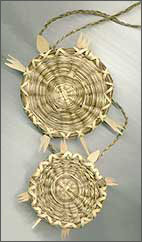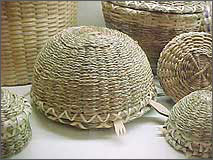Home
About Us
Current News
Event Calendar
Artist Bios
ARCHIVES
Display IDEAS
Collecting Tips
Gen Arts/Crafts Info
Testimonials
Hours/Directions
Online Store
ARCHIVES - Artist / Highlight of the Month
GERALD BARNES - March 2000
The Highlight of the Month program at The Indian Craft Shop focuses on a particular craft area, region or artist family/group. Our aim is to illustrate the diversity of tribal groups and the wide variety of artistic expressions and traditions in the country today.

Gerald Barnes takes great pride in continuing the tradition of Passamaquoddy basketry. "We believe our spirit and the spirit of our ancestors go into every one of our creations. I am in the shadow of my mother and my aunts, master basketweavers, known for their unique style of basketmaking," says Gerald. His first memory of weaving baskets is as a nine-year-old helping his mother, father, sisters and brothers make "scale" baskets which were large and sturdy, woven to carry a heavy load.. "Father did the hard work of preparing the ash and ribs. Mother did most of the weaving, with my sisters, brothers and I helping with whatever we could."
These baskets start out square at the bottom and end up round at the top. The Passamaquoddy made these utilitarian baskets for food gathering, fishing and storage long before contact with the outside world. Until the 1960s, scale baskets were in high demand by the local fish processing plants in Maine. Today, potato farmers use a similar basket. In the 1800s, basketmakers began selling their baskets to tourists visiting Maine in the summers.
"Each of my baskets represent the tradition handed down through generations," says Gerald. In addition to his parents, Max and Angela Barnes, Gerald credits his Aunt Clara Keezer for helping him. Clara was recently awarded a National Heritage Fellowship Award from the National Endowment from the Arts for her basketry.

"Patience is a virtue necessary for basketry," says Gerald. He uses brown ash and sweetgrass to make his baskets. He weaves a variety of shapes, including a miniature of the traditional scale baskets. He has become known for his acorn and turtle baskets. I wanted to carve my own niche as a basketweaver. So, I use the natural colors rather than dyes like my mother and aunt. I also chose a turtle as my symbol and have developed at least seven different sizes and shapes of turtle baskets." |
"Turtles are very important to our People. They represent longevity because they live long lives. They represent sustenance because they are a food source. But, most importantly, turtles show how well we are taking care of the environment. Polluted food and water easily affect turtles. When I make a turtle basket, I make it imperfect. Sometimes you'll have to look hard to see the imperfection, but I want people not only to appreciate the beauty of the basket, but also to understand the imperfection of my turtle. My hope is that the basket will inspire each person to take some action to protect the environment."
"Preparation of materials is often more time-consuming than the creation itself," says Gerald. He uses tools that were passed down from his father, who received them from other family members. He has taught his three children to weave and is always willing to share his gifts with the community. He has lectured and demonstrated for elementary schools, community colleges, museums and art fairs, including the Mashanucket Pequot Museum, and the Smithsonian Institution's Renwick Gallery and exhibited work in the Smithsonian's "Stories of the People."
©The Indian Craft Shop 2003


